
Reliving Alabama History
by Jo Freeman

When I was a child growing up in California, we sometimes
drove across country to my mother's childhood home in northwest Alabama to
visit the relatives. I picked up a little Alabama history on these trips,
but only recently did I learn how much I didn't know.
At the invitation of an Alabama cousin, I spent May Day, 2004 in a cow pasture in Blount County, Alabama, witnessing a Civil War re-enactment.
There I discovered the hidden history of the civil war inside the state of
Alabama. Why did I go? Because I was curious about family history that was
radically at odds with what I had always assumed was true.
As a child I thought every Southern family had a Confederate
ancestor. I never asked my grandmother who our's was, or if I did, she didn't
tell me. Over forty years later I found out why.
My great-grandfather fought in the Civil War, but he fought
for the Union Army.
Family is central to Southern society, and on those visits
to Marion County my grandmother spent time telling me who was related to whom
and sometimes introduced me to fourth and fifth cousins I can barely remember.
When I stayed with her and one aunt for the summer in 1955, we often tended
the family graves. I didn't notice that the cousins and the graves were all
on her side of the family. My grandfather's side -- the relatives of her husband
to whom she was deeply devoted -- was completely ignored. Indeed I never heard
her mention the names of any of her in-laws.
Ten years ago the cousin who brought me to Blount County
told me that my great-grandfather's name was Andrew D. Mitchell, a name I
had never heard. Even my mother had professed no knowledge of him, though
she was 22 when he died. Fortunately my cousin's mother, nine years older
than her sister, had told her daughter about the Unionist skeleton in the
family closet.
In the previous year I had learned that there was an entire regiment
of white Alabamians who fought for the Union, with the 1st
Alabama Cavalry USV, in addition to six Alabama regiments of soldiers
of African descent. The 1st Alabama was organized in 1862, when Union troops
occupied sections of north Alabama. My grandfather and two of his brothers
were recruited for Company L when it was formed in September of 1963. Officially,
some 2,576 white Alabamians enlisted in the Union armies, 80 percent in the
First Alabama Cavalry, USV. Every Confederate state except South Carolina
had enough white union supporters to fill at least one regiment; Tennessee
had 51 white regiments. These men came largely from the mountainous areas
of each state, where slavery never flourished. There were few slaves and little
sentiment about slavery, pro or con, among this population of overwhelmingly
white, Anglo-Saxon, Protestant poor farmers.
They saw the sectional conflict as a "rich man's war and
a poor man's fight". While most were neutrals who preferred to stay home and
stay out of the struggle, when faced with the Confederate draft some joined
the Union army instead. In their home states they were denounced as traitors
and derisively called the Tories of the Hills.
Their service with the Union was a mixed bag. The Southern
Unionists were on the winning side, and those who did not die got pensions.
But they didn't get the $100 sign-up bonus which army recruiters had offered
them to sweeten the deal. A court ruled after the War that these men were
refugees seeking protection when they joined the army and the Union didn't
have to pay the bonus. Without the bonus the families they left behind often
scrambled for subsistence, and frequently were harrassed by secessionist sympathizers
among their neighbors.
The Union generals welcomed local manpower, but didn't trust
it. The officers of the white Southern units were all from the North, mostly
the midwest. The men didn't get the same training as the regular units, and
were used largely as support troops, foraging for food in the surrounding
countryside.
Confederate units were also raised from this area, and sometimes
men switched sides when captured. This made them not just draft dodgers but
deserters, who could be killed on recapture. Because of the split sentiment
in northern Alabama during the War, atrocities were carried out against the
noncombatant population by both sides. Former friends and neighbors killed
and robbed each other in service to their respective causes.
Once Reconstruction was over, those Union soldiers who stayed
in the South were often treated as traitors by their communities. Some companies
in the 1st Alabama had marched with Sherman through Georgia, destroying and
pillaging as they went. In Southern historical memory, this was the worst
atrocity of the War. Long before the decade of my childhood the fact that
any Southerners had fought for the Union, or been part of Sherman's march,
was erased from common knowledge. My grandmother never told me about Andrew
D. Mitchell because in her world he was a traitor.
Civil War re-enactments are a popular pastime. I had seen
advertisements for some in New York, but I had never been to one. They are
particularly popular in the South, where most of the battles of the War were
fought. The one my cousin invited me to observe was the 141st anniversary
of the Forrest-Streight Raid -- a series of skirmishes across northern Alabama
that took place in late April and early May of 1863. I had heard of Confederate
Gen. Nathan Bedford Forrest, but not of Colonel Able Streight who led the
Union forces, including two companies of the 1st Alabama, in these scuffles.
He surrendered on May 3.
Civilians were kept away from the battle by a long stretch
of yellow police tape. Also behind the line was the 5th Alabama Regimental
band. I learned from Melissa, who played the flute, that bands were present
at real battles as well, usually one for each side. Music was used to egg
the fighters on. Re-enactments only have one band, and it's kept out of the
battle zone.
This reenactment was a three day event, though most of the
action was on Saturday. The highlight was a two hour battle in which cannon
were shot and men dressed in blue and grey pretended to fight. They are very
careful about the pretense. Even though blanks are used, the Rules specifically
say "Weapons will never be fired directly at opposing participants. ELEVATE!
ELEVATE!! ELEVATE!!!" The rifles didn't impress me, but those cannon looked
real, and they gave off a loud boom and lots of smoke. I jumped three feet
at almost every boom, but the dozen horses brought by their owners didn't
even flinch. They must be used to this.

There was supposed to be a reunion of descendents of the
1st Alabama, which was why my cousin had urged us all to come. Although we
were registered separately and given identifying blue ribbons to wear, an
actual meeting of descendants wasn't in the schedule and didn't happen. There
was a morning panel presentation by six writers and reseachers on the 1st
Alabama and the local civil war, but the only acknowledgement of their descendants
was at the end of the day's battle when both sides lined up and saluted us.
Instead of talking to descendants as I had expected to do, I queried reenactors,
trying to ascertain what brought people to a cow pasture on this pretty day
in May.
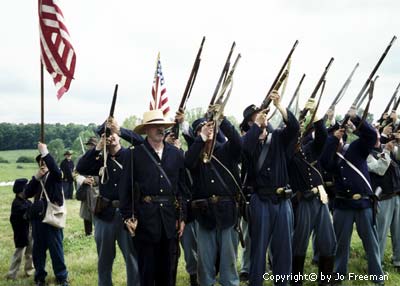
These reenactments are a form of adult play, where, as an
insurance salesman from Winston County told me, "we get to be kids again,
shoot guns and camp out." The key difference between this and other forms
of adult play is that it demands close attention to history. The men and women
who don period garb are as serious about getting it right as the professionals
at Williamsburg. Some got into this through their love of history; some because
of their family history; others were recruited by friends or family and the
dedication to history followed.
It's not a cheap hobby. From the sutlers (merchants) who
pitched their tents on the edge of the battlefield, I learned that it can
cost from $200 to $2000 to buy a period uniform. Because it takes two sides
for a battle, most reenactors have both blue and grey uniforms. They also
have to buy their own fake weapons and leather accessories. The loud booms
and smoke that came from the cannon cost several dollars each.
Women can play too. One tent sold period dresses at prices
ranging from $200 to $300 each, and that's before the shoes and the hankies
and the hats are added. I saw dozens of women walking around in 19th century
clothing. Most chose to dress well, like women of the plantation class attending
a ball. A few chose the plainer dress of the farmer's wife and daughter. Some
dressed-up their children as well. Those in period clothing were invited to
a Ladies Tea on Saturday morning. Farmer's wives and ladies shared the refreshments,
but anyone not in period clothing was shooed from the tent.
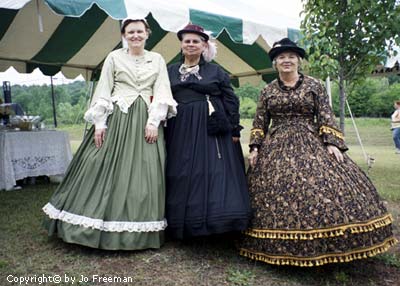
At the Ladies tea
At one time this was "daddy's hobby" as one sutler told me.
Now it's a family hobby. One consequence of the women's movement was women
demanded that they be allowed to play soldier as well as farm wife and lady.
Their demand was aided by historical research which showed that at least 257
women were soldiers in the War ("They Fought Like Demons: Women Soldiers in
the Civil War" by Lauren M. Cook and De Anne Blanton). Women dressed like
men, with their sex becoming known only with death, disability, or memoirs
and newspaper articles written later. Most joined up to stay with their husbands,
fathers or even brothers. A few joined on their own.
The re-enactors have the same requirement; women soldiers
have to pretend to be men. Although most of the re-enactment was fought at
a distance, I did see one person in a long skirt, carrying a battle flag.
I could not find her afterwards, to ask whether women openly did that during
the War. Women are more common among the re-enactment bands. About one fourth
of the Alabama 5th band are women. While they wear the regimental uniform,
Melissa told me that they aren't under the same pressure to hide their sex.
She followed her father into this hobby, but chose band rather than battle
as her place to play. It's a cheaper place. Participants only need to buy
one uniform, and often their expenses are paid. They use the modern versions
of period instruments rather than recreated versions. One man told me that
it would cost $100,000 to outfit a band with good copies of the actual period
instruments.
The Union and Confederate camps were separated by a creek
and a hike from the general event area. I didn't get over to visit them but
the people I spoke to told me that they too are meant to be authentic. The
rules require that "no modern items are visible.... while the camps are open
to the public." The people who do this have to become very knowledgeable of
the items they use, and spend hours explaining how old things work to the
general public. I spent some time at the photographer's tent, where I learned
how daguerreotypes were made as well as about the photographers of the War.
I watched the photographer's assistant roll chemicals on the back of a glass
plate to harden an image. For $30 this photographer would place you in period
clothing and period poses and make a personal glass etching. I didn't see
a lot of customers, but he assured me that there are enough to support his
hobby.
I was told that the turnout for this re-enactment was rather
small; some attract as many as 8,000 people. The vendors are probably the
only ones who make any money at these events. Those who sold modern T-shirts,
books and googaws were kept distant from the sutlers who sold period clothing.
The T-shirts, spread out under a Confederate battle flag and a sign that read "Blount
Co. Friends of Dixie, Preserving Our Southern History and Heritage", displayed
designs that were heavy on soft-core porn -- half naked women in suggestive
poses with various military and regional symbols. The books, on the other
hand, were scholarly studies of local history and civil war activity. I picked
up four on northern Alabama history by authors and publishers you won't find
in your local bookstore. Andrew D. Mitchell was in the index.
Please click
on thumbnails to see the larger photos. |
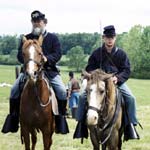 |
|
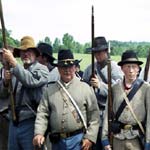 |
| Union re-enactors |
|
Rebel re-enactors |
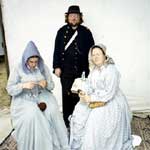 |
|
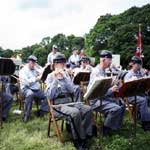 |
| Posing in the photographer's
tent |
|
The Fifth Alabama CSV Regimental
band |

|
| Dixie is ever
present
|
|